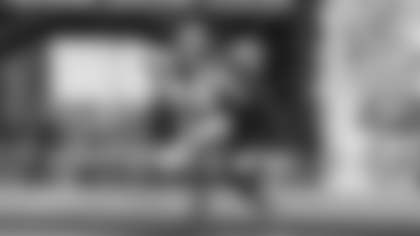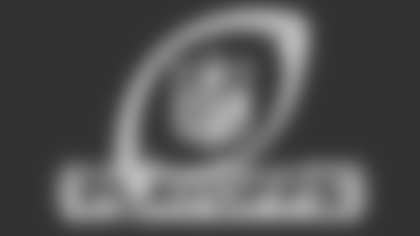When the Patriots selected QB Drake Maye third overall last April, most pundits and league decision-makers had the same question: would Maye be able to refine his game to be more consistent from the pocket?
At the time, you couldn't find a single person who doubted Maye's physical gifts. At nearly 6-5, 220 pounds, Maye looks the part walking off the bus: excellent size, arm talent, plus-mobility, and deep accuracy. In college, Maye led his entire draft class in big-time throws over his last two seasons at North Carolina – those were the selling points.
However, Maye's detractors argued that he wasn't consistent enough at the "easy" things to be a winning quarterback in the NFL. On tape, the 22-year-old would sometimes miss the bunnies due to inconsistent accuracy and some reps where timing and anticipation were an issue. For the Maye believers like yours truly, the thought process was that he could clean up the details to become a more consistent in-structure passer while still creating the splash plays. If he combined those two things, Maye would be a franchise quarterback in the elite conversation.
Although he still has some final hurdles to clear, the most impressive aspect of Maye's film during his rookie season is how quickly he's winning from the pocket. Even someone like this scribe, who pounded the table for Maye before the draft, didn't think it would happen this fast.
According to NextGen Stats, Maye ranks tenth out of 31 qualified quarterbacks in completion percentage over expectation (CPOE) on throws within 20 yards of the line of scrimmage (+2.9%). The Pats rookie is also 11th among qualified quarterbacks in expected points added on short throws (0-9 yards), with an impressive +0.27 output. On Sunday, Maye produced career-highs in passing yards (282) and EPA per drop-back (+0.27) with an average target depth of 5.7 yards vs. the Rams, efficiently picking apart LA's underneath coverages.
For Maye, this translated on film as a quick decision-maker who read out underneath coverage well and understood where his answers were against pressure. In our grading, Maye had 15 plus plays to only five minuses, all while only throwing two of his 40 pass attempts over 20 air yards. Long story short, he won by doing the "easy" things many doubted he could do at this level.
Along those same lines, Maye's progress in this regard is also a testament to him and offensive coordinator Alex Van Pelt adapting to the Patriots personnel. New England has a shaky offensive line that ranks 32nd in pass-blocking win rate. The Pats are also limited weapons-wise, without any proven ball winners outside the numbers for Maye to throw deep.
Rather than forcing a round peg into a square hole, Maye and the coaching staff have built the passing offense around their strengths, which are tight ends Hunter Henry and Austin Hooper, slot receiver DeMario Douglas, and in-breaking route winners Kayshon Boutte and Kendrick Bourne. The Pats are running a quicker-hitting passing game between the numbers, and as a result, the pressure rate on the quarterback has dropped from 48.1% to 34.4% in Maye's starts. This week, while facing the second-best pass rush in pressure rate, Maye was under pressure on a manageable 39.1% of his drop-backs.
Eventually, the hope is that the Patriots will acquire receivers and upgrade the offensive line to improve their deep passing game. Maye has always had a great deep ball, there's no question about that. Right now, it's just not being showcased because of the personnel around him, which might end up being a good thing for him in the long run.
Maye being forced to win from the pocket on short and intermediate throws could be great for his long-term development. Again, this is the area of his game where there were concerns. So, by mastering these elements in his rookie season, he can now add this to his repertoire along with the out-of-structure playmaking and deep passing ability that we've seen in flashes. If and when the Patriots get him viable deep threats, and you add that to what we're seeing from his short game during his first season, look out, folks. Maye is going to be a problem.
Here is a thorough review of the Patriots defense and quick-hit film notes from the loss to the Rams After Further Review.
Patriots Defense: How the Rams Used Motion to Defeat New England's Man Coverages
After their best defensive performance of the season last week in Chicago, the Patriots followed that up with one of their worst statistical performances of the year vs. the Rams on Sunday.
New England generated a season-worst -19.4 total expected points added against Los Angeles, surpassing their Week 3 loss to the Jets as their worst EPA output of 2024 (-18.8). The Rams gained 7.88 yards per play, seventh-best in a game by any team this season, and generated a 53% play success rate, which ranks in the 92nd percentile – it wasn't a good day at the office.
Before we get into the details, the big-picture perspective is that the Patriots are suddenly short on personnel defensively. Maybe they can get a fully healthy Christian Barmore back with LB Ja'Whaun Bentley and possibly S Jabrill Peppers next season. That would certainly help. Still, as we start thinking about the 2025 offseason, it feels like the Patriots are a three-down defender short on the defensive line, need a field corner/CB2 to play opposite Christian Gonzalez, and lack depth at the inside linebacker position. Eliot Wolf cannot ignore those needs.
From a schematic perspective, this game felt like Rams head coach Sean McVay getting the better of a first-year defensive play-caller in DeMarcus Covington. That's not a shot at Covington. It's his first year on the job, and McVay is a top offensive mind in the NFL. Although there were some minor differences, Covington and head coach Jerod Mayo had a similar game plan for the Rams as their plan that shut down the Bears offense in Week 10. New England played a 59.3% man coverage rate (61% vs. Bears) and frequently rushed five pass-rushers in single-high structures.
Following the game, there was a big to-do about top CB Christian Gonzalez playing the boundary rather than shadowing Cooper Kupp or Puka Nacua, who combined for 13 catches, 229 yards, and three touchdowns. There was also second-guessing about the Pats not deploying any double teams on the Rams wide receiver duo, and those might be fair criticisms, but that wasn't the issue with their game plan from this perspective.
When you play an offense like the Rams, they make it challenging to bracket or double receivers with their condensed formations and motions. It's easy to bracket receivers who play in stagnant offenses because you can lock in pre-snap on those assignments. However, it gets complicated when receivers are in tight to the formation, and when they motion, that's another layer. Do you reset the bracket? Do you have both defenders follow the receiver? When they motion at the snap, that's another easy way for McVay to render the bracket obsolete.
My biggest gripes with the Patriots game plan on defense were the decisions to blitz a 16-year veteran quarterback 18 times while looking unprepared for LA's motions. The Rams came into the week ranked second in how often they motion (81.9%). On Sunday, they motioned at or before the snap on 83.3% of their offensive plays. In other words, New England should've been fully prepped for the Rams motion-heavy offense, and at times, they looked lost. On average, the Patriots defense allowed 9.2 yards on plays with motion compared to 4.5 yards per play without motion vs. the Rams.
For example, there were instances where the Rams produced wide-open receivers by motioning at the snap against the Patriots man coverages. Above, Nacua runs a quick return motion to gain leverage/momentum into his route. Gonzalez and CB Marco Wilson sort this out poorly, with Gonzo taking the inside release, expecting Wilson to cover the flat. Instead, both CBs go with Robinson, leaving Nacua uncovered. On the next play, LA runs a curl-flat quick game where they roll Kupp into his flat route. Again, the DBs aren't on the same page, as Wilson switches while Marcus Jones sticks with Kupp, so nobody has Robinson.
This time, the Rams send Nacua in motion at the snap as a way to disguise play-action. Nacua could be adding on as a blocker to fit up to the second level. At the same time, Jon Jones is likely expecting Nacua to continue out the other side of the formation, but Nacua releases through the C-Gap, creating easy leverage for Puka on a crosser that gains 37 yards on the Rams opening drive.
Lastly, we know about the Patriots dialing up four cover zero blitzes, which Stafford shredded: 4-4, 92 yards, three touchdowns (69-yard TD to Kupp). Stafford also beat cover zero for a key third-and-3 conversion late in the game, forcing the Pats to use their timeouts to get the ball back while also creating a more favorable field position for Los Angeles.
New England also used five or six-man rushes (adding on a rusher with the RB in blitz pickup) on 18 drop-backs. The issue with bringing extra defenders in the pass rush was that it forced the Patriots to cover in six-man zones or with only post-safety help in center field.
In this clip, the Patriots try covering the Rams four-man distribution with six zone defenders. To the quarterback's right, they have four defenders to three receivers, so they should be okay. However, here comes that pesky motion again. When the Rams motion Nacua across the formation, it forces S Kyle Dugger to cover him with Dell Pettus rotating to the post while widening the field. The Pats then drop into cover three, with Dugger as the curl/flat defender. With the outside corner off, Dugger has to get into the curl window here and force Stafford into a check-down. Instead, Wilson is in a tough spot, and it goes for a 25-yard gain.
New England trusted their corners to cover on islands in a blitz-heavy plan, and LA won those matchups. To be transparent, I thought they'd hold up better in the secondary against the Rams wideouts than they did. However, I also figured the Patriots would play more coverage, with multiple help defenders in the middle of the field to leverage in-breaking routes. Despite blitzing 66.7% of the time, LA held the Pats to a 25.9% pressure rate. Plus, motion tests communication and makes it tougher for the primary coverage defenders to stick with their man.
Based on the film, it's not surprising that the Patriots decided to waive Wilson on Monday, who wasn't on the same page with his teammates, but it wasn't just Wilson who struggled. Along with waiving Wilson, there are other personnel tweaks one would expect the Patriots to make soon (Wilson waived, Takitaki over Elliss, Ekuale's role reduced, etc.).
In the battle of wits, McVay got the better of Mayo and Covington on Sunday. Next week, they'll face the top offense in motion rate in the Dolphins, so they better get this fixed quickly.
Quick-Hit Film Notes From Patriots-Rams After Further Review
Offense
- This offense is leaving meat on the bone with their play-action concepts. Whether it's selling the fake or pairing routes with the blocking schemes, it should be better than 7-of-9 for 50 yards (5.6 YPA). My nitpick with AVP here is that they're trying to hit longer developing routes rather than zipping the ball past the second level, like when they ran play-action off a lead concept with Sidy Sow eligible at fullback. Why a deep curl-deep over route combination there? Have Sow draw in the linebackers and hit it right behind the second level.
- Last week, RB Rhamondre Stevenson left some plays on the field. This week, there was one iffy run early where he had happy feet in the backfield instead of hitting the open A-Gap (QTR 2, 7:13). But, by and large, this was better tape for Stevenson. He had two vintage Rhamondre runs for 10 and nine-yard gains where he saw cutback lanes/bounces well and finished through contact. Although he gave up one pressure, Stevenson was also huge in blitz pickup in this one, saving the Lowe TD when Onwenu fell off his block. A step back to his usual standard.
- WR Kendrick Bourne was much sharper with his routes and his improved timing with Maye produced 29 yards after the catch. The back-shoulder fade (18 yards) to get the final drive started was a good sign for this QB-WR pairing, as that's a route conversion where the duo needs to be on the same page, and they were this week. Bourne's TD was another example of a receiver winning on his route and the ball being on time – perfect offense. The Pats need that version of Kendrick Bourne for the rest of the season. He was effective in this game.
- TE Hunter Henry was again reliable with six catches for 63 yards on nine targets. His feel for navigating the middle of the field, where Maye hit him numerous times over the ball and on crossers, gives them an advantage between the numbers. The anticipation to convert a third down is another example of their chemistry. The lone blemish on Henry's tape was a blown block on the third-and-2 run before the Pats kicked a field goal to make it a six-point game.
- Although the player deserves most of the credit for making the plays, kudos to AVP for finding the right role for DeMario Douglas. Douglas being their primary target on RPO slants, screens, and crossers designed to create foot races for the speedy slot receiver is good offense.
- WR Ja'Lynn Polk was open for a big play on a crosser and might've been a better option on the strip sack. Still, he was inconsistent as a run blocker, and jumping offside on 4th-and-1 killed a play set up nicely to convert in that situation. Coach Mayo said he thought the play they had on would've gone for a touchdown.
- WR Kayshon Boutte separated well on a slant, made a tough catch where he took a big hit on a third-down crosser, and caught a hitch in HOSS Juke. However, his third-down drop early in the game likely cost the Patriots a chance at three points. It would've gotten them in FG range.
- My assessment of the film was much friendlier to RT Trey Jacobs than PFF, who had him with six pressures allowed (sack, five hurries). I didn't see it that way. In my charting, Jacobs allowed three hurries, with the sack assigned to Maye and the left side for failing to pass off a stunt. He got beat a few times by scheme when LAR rushed two over him, and his hurry allowed on the INT likely contributed to the throw sailing on Maye. Overall, Jacobs held up well one-on-one against pass-rushers Byron Young and Jared Verse, who each had nine reps vs. him.
- LT Vederian Lowe had some issues in this game, with an inside swim move beating him for a pressure and a hold, while he didn't pass off a T/E stunt with Jordan, causing Maye to pull the ball down and take a sack. I also had Lowe with two blown blocks on run stuffs, one going to his side on wide zone weak and on the backside of a trap scheme.
- My guess is the Patriots will err on the side of continuity with the left guard spot, but it's getting shaky for current starter Michael Jordan. Jordan allowed two hurries and had a difficult time sustaining blocks in the run game. The veteran's initial engagements are fine, but he loses late in reps too often in the run game, possibly because he's getting overpowered. I also put the illegal formation penalty on him because Lowe is lining up based on where Jordan is relative to the line of scrimmage, and Jordan was in the backfield. He got away with it again later.
- RG Mike Onwenu had some difficult assignments against Rams DT Kobie Turner, who is a terrific player. Onwenu had a great combo block on Stevenson's 10-yard run and had other moments where he moved defenders off the ball. However, he also got beat by Turner for a hurry, lost on his block on Lowe's TD, and was responsible for a run stuff.
- C Ben Brown had an excellent combo block on a 12-yard duo run in the first quarter. But he's having some issues with post-snap line movement. Brown was responsible for the strip sack when he didn't pick up Fiske on the T/T stunt and allowed another hurry on a three-man game. I also believe that Jordan's false start penalty was an "everybody but the center" moment, meaning the center didn't snap the ball on time, but that's just an educated guess.
- QB Pressures: Jacobs (three hurries), Lowe (three hurries), Onwenu (two hurries), Brown (sack, hurry), Jordan (two hurries), Stevenson (hurry).
Defense
- As mentioned, the Patriots defense lost the battle in the trenches, including against the run. The Rams used a GY (guard-Y tight end) counter play and inside traps to get downhill, and then opened up the wide zone runs. The Pats must play blocks better in the interior to effectively build a wall in their two-gapping mechanics and cover cutback lanes. The secondary run force needs improvement. There were instances where there either wasn't that second layer on the edge to force the ball back inside (Q2, 9:49) or two defenders were fitting the same gap rather than having one defender play the outside responsibility (Q3, 4:15). LA's 52% rushing success rate ranks in the 91st percentile – the Rams won that battle this week.
- DL Keion White was the Patriots most impactful defender in this one. White tied for the team-lead with two run stuffs and logged two pressures (hit, hurry). He played the edge well on an early stuff stepping upfield to cut off the corner (QTR 1, 10:14), executed a T/E stunt for his second run stuff, and had a critical batted pass that saved a big play. White was one of the few defenders who was disruptive and gave the Rams problems in this game.
- CB Christian Gonzalez mostly played the boundary on Sunday. However, he lined up on Kupp and Nacua more than the numbers suggest. According to NGS, Gonzo had six coverage snaps on Kupp and one on Puka, but he was on Nacua several other times on run plays. Overall, Gonzalez allowed just nine yards into his coverage on four targets with two coverage stops, including a key third-down stop in the fourth quarter covering Kupp (QTR 4, 11:49). Gonzalez did his part.
- DT Christian Barmore played 21 snaps in his return (40%) in numerous situations. It's a fantastic feat that he was even out there. However, he was understandably rusty. Barmore's pad level in the run game and technique to absorb double-teams will need reps to build back up, while he lost his balance on his lone 1-on-1 in the pass rush where he went with a slap move on Rams RG Kevin Dotson. Barmore didn't register a pressure or a run stuff but was impactful drawing five double-teams, helping create a QB hit by Christian Elliss on a third-down stop (Q1, 3:05). I'm by no means judging the film with Barmore yet. He's still working his way back.
- S Kyle Dugger was hard on himself for missing three tackles in his return from a three-game absence. He also got a little lost as the curl/flat defender on a 25-yard explosive to Nacua and looked like he should've played outside his block on an eight-yard run. Dugger is typically a sound tackler, so I'm not too worried about that.
- DT Daniel Ekuale is a useful rotational pass-rusher on the interior who is 1. Playing through an abdomen injury, and 2. Being asked to play as an early-down base end. Ekuale logged a 63% snap rate with 19 run defense snaps. He did have two stuffs, but he was also at the point of attack on an 18-yard and 12-yard run by LA. With Barmore returning, Pharms emerging, and two IDLs inactive (Wise, Roy), it's possible that Ekuale's role will be decreased moving forward for more sturdy run-stuffers.
- LB Christian Elliss is another front-seven defender offenses target in the run game. He missed a tackle in the backfield on a potential TFL and was on the scene for an 18-yard run, a seven-yard run, and a five-yard run. It also appeared that Ellis allowed the 19-yard TD to Parkinson when he bit too hard on the play-action fake as a backside pursuit player. Sione Takitaki isn't fully healthy, which is why Elliss doubled him up in snaps (36 to 18), but this scribe would like to see more Takitaki.
- CB Jonathan Jones had a rough game, tweeting out that "I owe NEP better than today" following the loss. Jones got beat for three touchdowns, including the 69-yard TD to Kupp on an all-out blitz, where he was probably better off limiting the damage by going for the tackle rather than the ball. Jones is still a useful player in a slot/safety role, but the Pats need to limit his exposure to single-man coverage.
- It's unsurprising that the Patriots waived CB Marco Wilson on Monday. He had a tough time passing off motions and got beat on a 25-yard explosive covering Nacua in two-man (Seattle route). You could argue that Wilson shouldn't be matching up against the opponent's top receivers, but it's time to see what Alex Austin can do.
- I continue to like Jeremiah Pharms's run defense tape. He logged two run stuffs, putting teach tape out when he defeated a double-team block by squaring up the base blocker for a perfect rep (QTR 2, 8:04). Pharms should be an early-down base end moving forward.
- Pressures: Elliss (hit, hurry), White (hit, hurry), Gonzalez (hit), Jennings (hit), Dugger (hurry), Johnson (hurry). Run stuffs: Pharms (2), Elliss (2), White (2), Ekuale (2), Gdochaux (1), M. Jones (1).
- Coverage: J. Jones (6/4/123 yards/3 TDs/PBU), M. Wilson (3/3/58 yards), M. Jones (6/3/37 yards), Tavai (2/2/27 yards), Elliss (1/1/19 yards/TD), Dugger (1/1/10 yards), Gonzalez (4/2/9 yards), White (1/1/7 yards), Jennings (1/1/5 yards), Pettus (1/0).
DISCLAIMER: The views and thoughts expressed in this article are those of the writer and don't necessarily reflect those of the organization. Read Full Disclaimer












































